
|
Photo Gallery |
|
|
| Go to the Main Page of Port Of Nagoya Publick Aquarium |

Port of Nagoya Public Aquarium is located at the west end of Port Bridge. On the other end of the bridge, the icebreaker Fuji is parked. Fuji traveled to Syowa Station (Japanese research station) in Antarctica 18 times from 1965 to 1984.
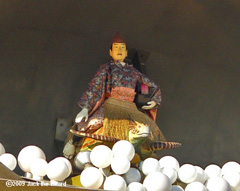
|
Port of Nagoya Public Aquarium shows many fish and creatures along the route to Antarctica just as the icebreaker Fuji took. It starts from "Sea of Japan", then "Deep Sea Gallery", "Tropical Marine Life", "Australian Freshwater Life" and "Antarctic Marine Life". The aquarium leads the research and conservation of the loggerhead sea turtle. Chelonian Research Institute is located outside of the aquarium pavilion. The Institute is free for entrance. You'll find this in front of the aquarium entrance. This is actually a clock! The doll will come out from shell on the hour and tell the story of Japanese legend "Urashima-taro". To go to Port of Nagoya Public Aquarium, take Meiko-line subway to Nagoyakou (Nagoya Port). About 7 minutes on foot from the station's Exit 3 to the Aquarium. |
| You are right in front of the huge tanks after going through the ticket gate. "Under the Northern Light" and "Dolphin Pool". |
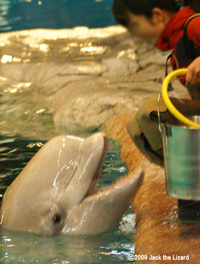
|
||
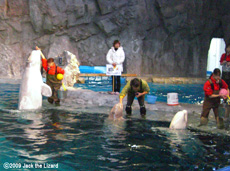
Beluga is also called Sea Canary. They inhabit in the arctic ocean and Sea of Okhotsk. |
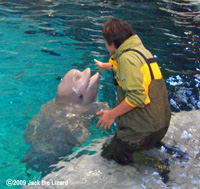
Nana was born in July 2007. She was training in eating fish (sandlance) just as her mother does. |
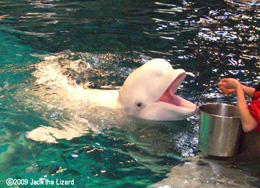
During the beluga training, their keepers explain us a lot about belugas. |
|
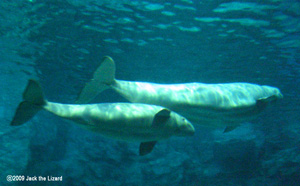
|
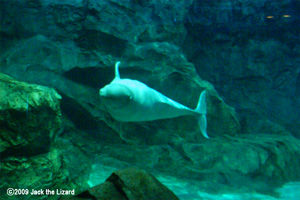
|
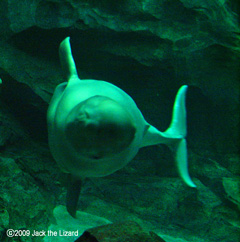
|
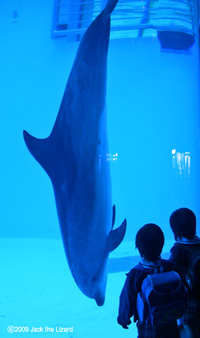
|
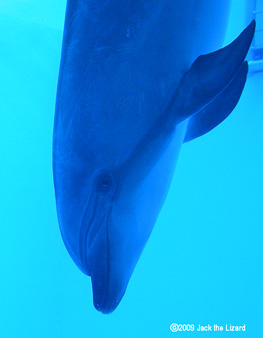 Is she looking at me?
Is she looking at me?
|
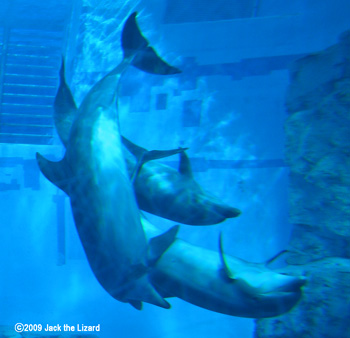
|
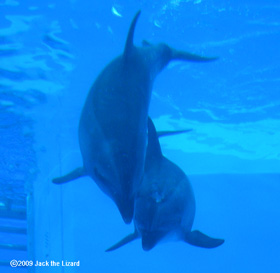 The dolphins swim as if they are fawning on each other.
The dolphins swim as if they are fawning on each other.
|
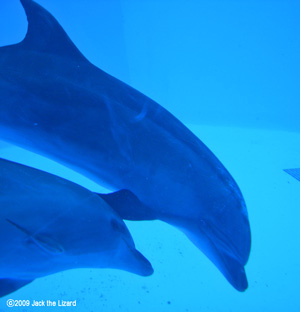 Do you see the two dolphins are keeping eye contact?
Do you see the two dolphins are keeping eye contact?
|
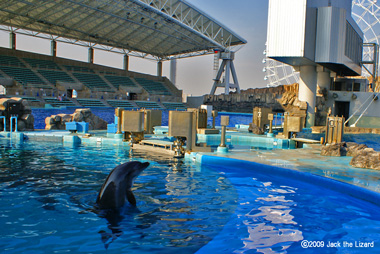
No trainers, no audiences. It seemed he was practicing the show performance by himself. |
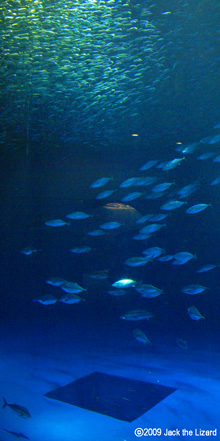
|
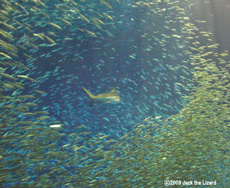 The scalloped hammerhead swims into the school of the Japanese pilchard.
The scalloped hammerhead swims into the school of the Japanese pilchard.
|
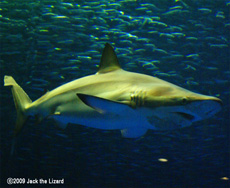 The copper shark
The copper shark
|
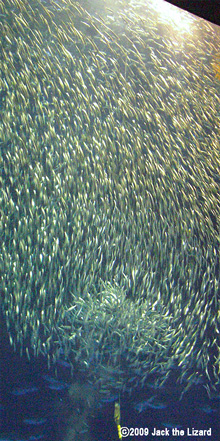 School of Japanese pilchard. The school moves just like a tornado.
School of Japanese pilchard. The school moves just like a tornado.
|
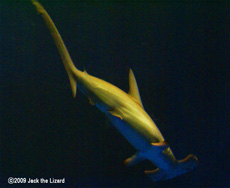 The scalloped hammerhead
The scalloped hammerhead
|
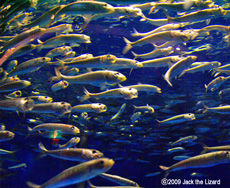 Japanese pilchard
Japanese pilchard
|
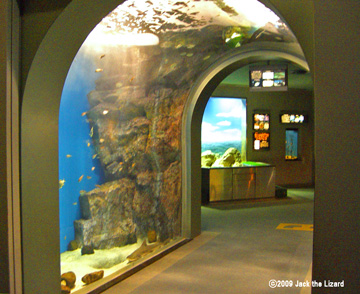
Fish swims above you. It is as if you are walking on the bottom of the ocean.
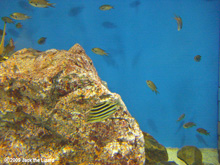 Striped one is the kagokakidai (Microcanthus strigatus).
Striped one is the kagokakidai (Microcanthus strigatus).The pearl-spot chromis is swiming above. |
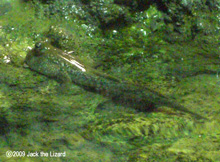 The lives on reed beds
The lives on reed bedsMudskipper |
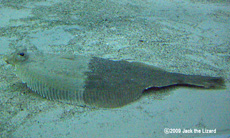 The see around Ise
The see around IseStone flounder |
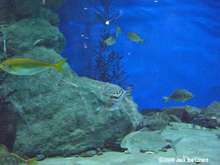 You can see the fish in the tonnel aquarium very close.
You can see the fish in the tonnel aquarium very close.
|
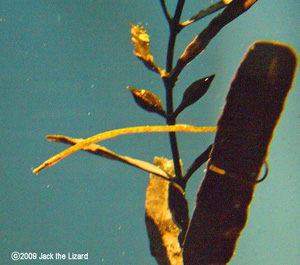 The seaweed pipefish looks like string.
The seaweed pipefish looks like string.It lives in seagrass beds which is like the shelter to hide from any predators. |
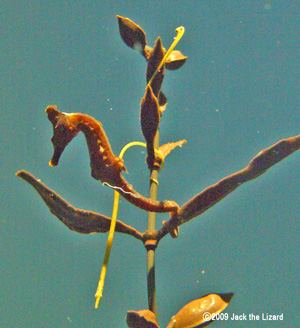 Seahorse and Seaweed pipefish
Seahorse and Seaweed pipefish
|
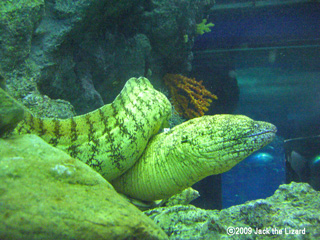 Y-patterned moray (Gymnothorax berndti)
Y-patterned moray (Gymnothorax berndti)
|
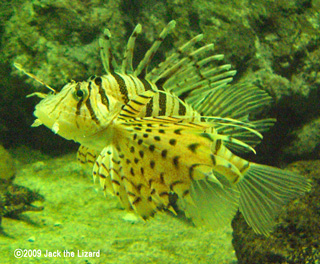 Lionfish
Lionfish
|
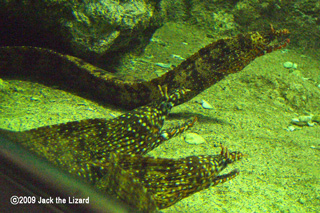 Leopard moray eel
Leopard moray eel
|
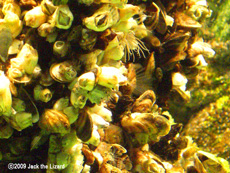 Barnacles
Barnacles
|
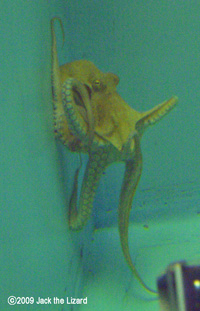 Octopus
Octopus
|
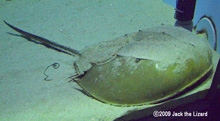 Horseshoe crab
Horseshoe crab
|
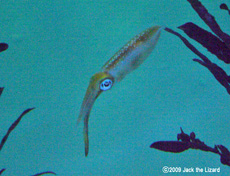 Bigfin Reef Squid
Bigfin Reef Squid
|
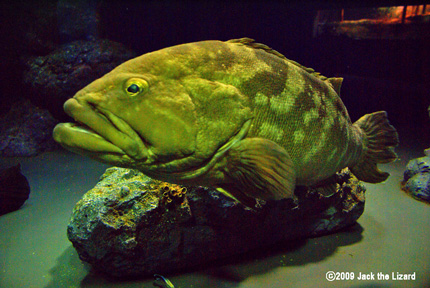
Longtooth grouper
There are some deep trenches around Japan such as Mariana, Izu-Bonin and Japan Trench. There are so many lives where the sun light has never reached on the ocean floor in those trenches.
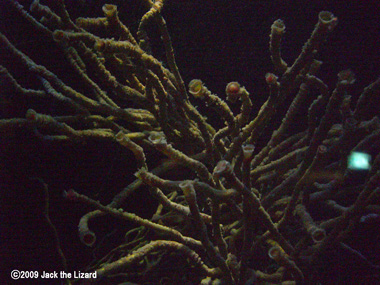 Lamellibrachia satsuma (tube-worms)
Lamellibrachia satsuma (tube-worms)
Plants can not photosynthesize in the deep sea where the sunlight does not reach. Lemellibrachia has symbionitic bacteria which can create the nutrition from hydrogen sulphide and methane leaking out of the seafloor for the Lamellibrachia. This Lamellibrachia Satsuma was found in Kagoshima Bay at a depth of 82 m. |
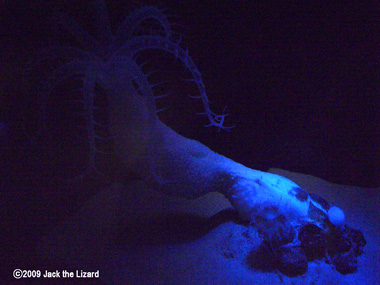 Bathyalcyon robustum
Bathyalcyon robustum
The simple cellular colonies are ranged at a depth of 150~600 m in Sagami bay, south west of the Kii Peninsula and the Malay Peninsula. |
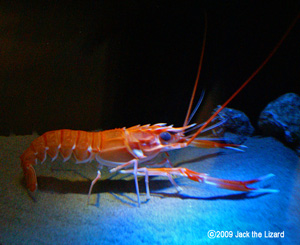 Japanese lobster (Metanephrops sagamiensis)
Japanese lobster (Metanephrops sagamiensis)
The lobsters inhabit at a depth of 300~640 m from Sagami Bay to north east of Taiwan. |
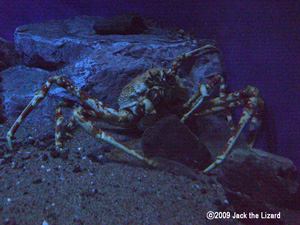 Japanese spider crab
Japanese spider crab
The crab inhabits at the bottom of ocean from off coast of Chiba Pref. to Kagoshima Pref. Full grown crab stretch out to the leg span of more than 3 m. It is the biggest crab of the world. |
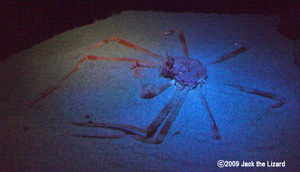 Crab-beetle (Chionoecetes opilio)
Crab-beetle (Chionoecetes opilio)
The crab inhabits on the muddy sea bottom at a depth of 150~750 m in the western Pacific Ocean off the coast of the Boso Peninsula to the Indian Ocean. |
Quite a number of Sea turtles in the North Pacific Ocean are born on the beaches in Japan. After hatching, the baby turtles enter the ocean and start swimming along Kuroshio current across the Pacific Ocean towards California and make a clockwise turn to Hawaii. Port of Nagoya Public Aquarium has studied the biology and the migration of the loggerhead sea turtle.
The special report about the conservation of loggerhead sea turtle is HERE!The special report about the research with NOAA on the migration route of the loggerhead sea turtle is HERE!
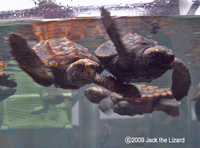
|
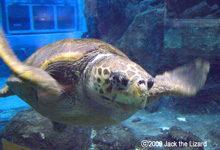
|
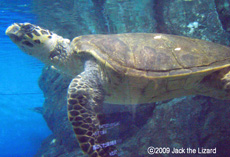
|
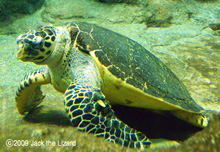
|
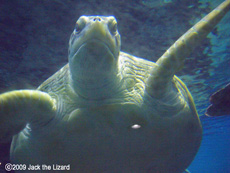
|
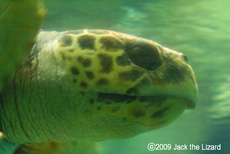
|
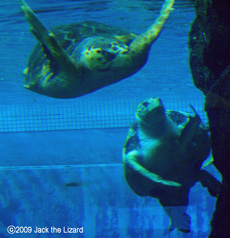
|
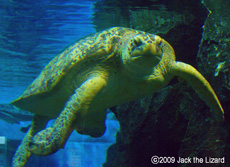
|
Emperor angelfish
The emperor angelfish live around coral reef. The juvenile and adult fish looks totally different color.
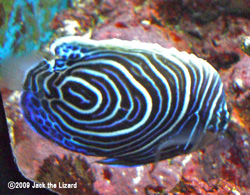 Juvenile
Juvenile
|
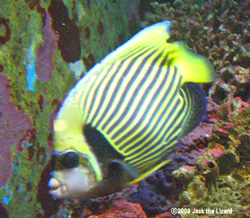 Adult
Adult
|
Clownfish and sea anemone are great partners. Fish provides foods to anemone, and anemone protects clownfish from its predators. A sea anemone has a lot of tentacles. A tentacle has a lot of cnidocytes which have function to sting and inject powerful poison. Usually, any fish and creatures do not get close to a sea anemone because of the poison, but clownfish won’t get hurt by anemone. The fish sleeps between the anemone’s tentacles at night.
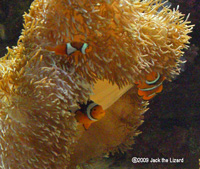 Bubble-tip anemone and Clownfish
Bubble-tip anemone and Clownfish
|
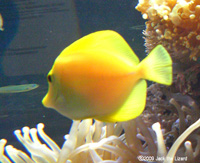 Yellow tang
Yellow tang
|
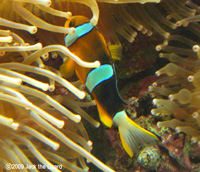 Clownfish
Clownfish
|
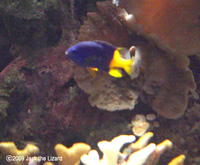
|
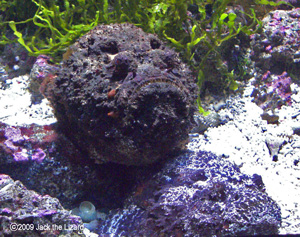 Reef stonefish
Reef stonefish
The dorsal fin has spines which inject venom. The fish are in the sandy areas on the coral reef. If you step on the rockfish with your bare foot accidently, you will be paralytic and dead. The reef rockfish is the most venomous fish of the world. |
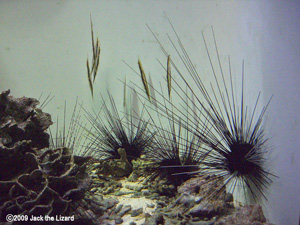 Striped Shrimpfish and Deadema setosum
Striped Shrimpfish and Deadema setosum
Diadema setosum has a sea urchin which has very long sharp spines. Shrimpfish has long thin flat body. When predators come, the fish swims in between the spines of the sea urchin. |
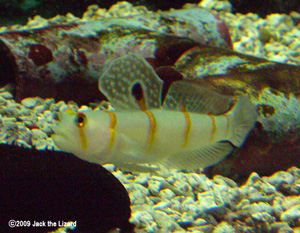 Randall's prawn-goby
Randall's prawn-goby
Shrimp makes a burrow to live in the sand and have a goby as her room mate. When any predators appear, the goby shakes the body quickly to tell the shrimp which has poor eye visions to get in to the burrow. |
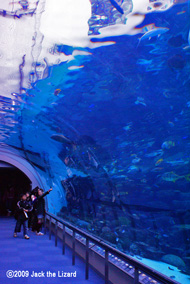 Under the sea tunnel
Under the sea tunnel
The huge tank keeps 140 different kinds of fish. 3,000 fish swims around the coral reef. |
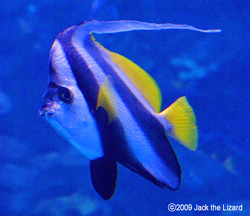 Pennant coralfish
Pennant coralfish
|
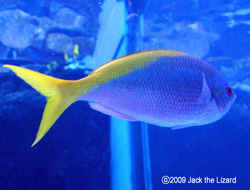 Pearl-spot chromis
Pearl-spot chromis
|
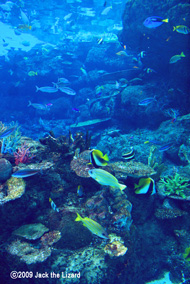
|
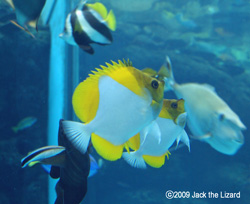 Oriental butterflyfish
Oriental butterflyfish
|
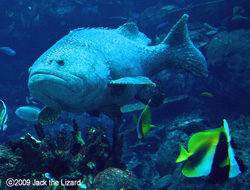 Giant grouper
Giant grouper
|
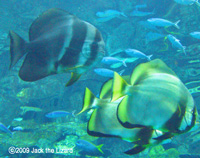 Batfish
Batfish
|
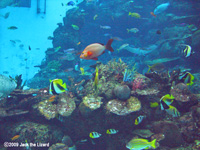
|
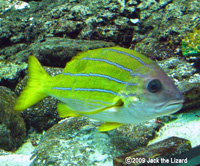 Snapper
Snapper
|
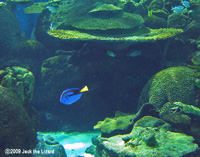 Blue tang
Blue tang
|
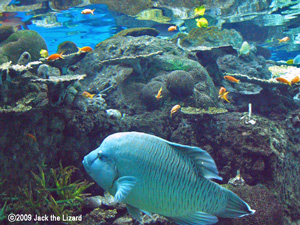 Humphead wrasse
Humphead wrasse
|
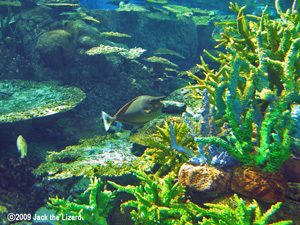 Surgeonfish
Surgeonfish
|
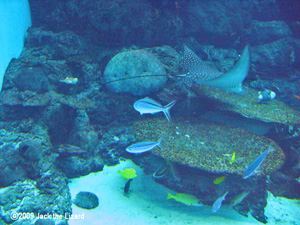 Blue-dash Fusilier and Spotted eagle ray
Blue-dash Fusilier and Spotted eagle ray
|
The environment around the fresh water rivers in Queensland in Australia is recreated in the tank.
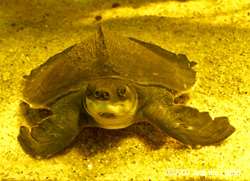 Port of Nagoya Public Aquarium succeeded in having the Pig-nosed Turtle breeding in captivity.
Port of Nagoya Public Aquarium succeeded in having the Pig-nosed Turtle breeding in captivity.
|
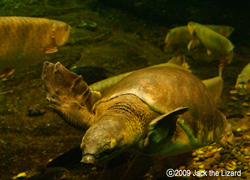 The Pig-nosed Turtle
The Pig-nosed Turtle
|
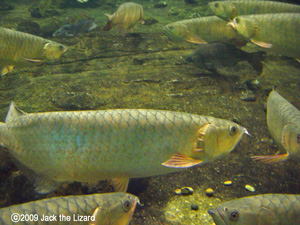 Arowana
Arowana
|
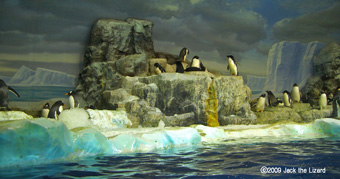 Penguin Pool. The temperature inside is always -2°C.
Penguin Pool. The temperature inside is always -2°C.
|
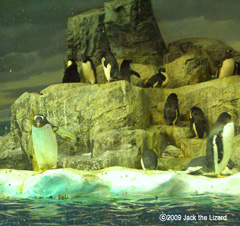
The Emperor Penguin, The Chinstrap Penguin, The Adélie Penguin and the Gentoo Penguin live here. |
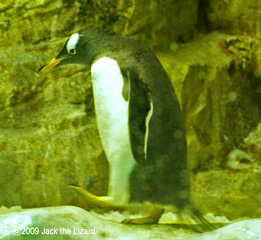 The Gentoo Penguin is waddling.
The Gentoo Penguin is waddling.
|
The penguins swim as if a birds fly in the sky.
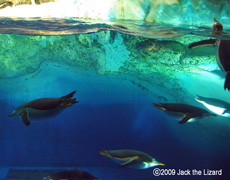
|
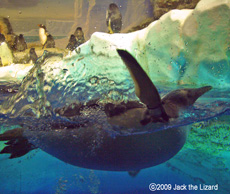
|
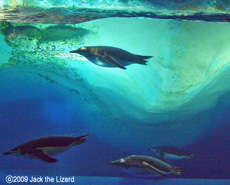
|
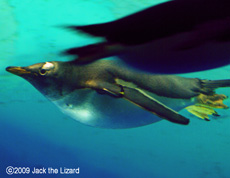
|